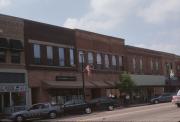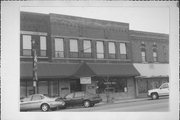Property Record
112-114 S MAIN ST
Architecture and History Inventory
| Historic Name: | Fair Store |
|---|---|
| Other Name: | Harbor Bike |
| Contributing: | Yes |
| Reference Number: | 116922 |
| Location (Address): | 112-114 S MAIN ST |
|---|---|
| County: | Waupaca |
| City: | Waupaca |
| Township/Village: | |
| Unincorporated Community: | |
| Town: | |
| Range: | |
| Direction: | |
| Section: | |
| Quarter Section: | |
| Quarter/Quarter Section: |
| Year Built: | 1900 |
|---|---|
| Additions: | |
| Survey Date: | 1998 |
| Historic Use: | small retail building |
| Architectural Style: | Commercial Vernacular |
| Structural System: | |
| Wall Material: | Brick |
| Architect: | Hans Knudson and Conrad Gmeiner |
| Other Buildings On Site: | |
| Demolished?: | No |
| Demolished Date: |
| National/State Register Listing Name: | Main Street Historic District |
|---|---|
| National Register Listing Date: | 4/12/2002 |
| State Register Listing Date: | 1/18/2002 |
| National Register Multiple Property Name: |
| Additional Information: | The old Fair Store building is a two-story commercial vernacular structure constructed of brick. The building has a brick corbeled cornice and a stone belt course over the second story openings that are filled with modern glazing. The first floor storefront has been enclosed with brick and glass with a modern glass and metal entrance. The old Fair Store building contributes to the architectural significance of the Main Street Historic District as an example of the commercial vernacular style. It is much more significant for its association with the Fair Store, one of the most important department stores in Waupaca. The building was originally constructed for the Union Store, a business where several different retailers located their stores under one roof, but remained economically independent. This unusual idea was not successful and in 1904, Nathan Cohen leased the building to enlarge his department store, which he called The Fair. This business was very successful and operated until the 1930s. The Fair Store is historically significant because it provided the consumers of Waupaca with the most updated goods and services during the first part of the twentieth century. It represents the growth and development of retailing in Waupaca and helped draw people downtown to visit other retailers, as well. |
|---|---|
| Bibliographic References: | Tax Rolls. Waupaca Post, 27 July 1899, p. 5. Wayne A. Guyant. "When Then Was Now." Waupaca Post, 24 December 1991, p. 18. |
| Wisconsin Architecture and History Inventory, State Historic Preservation Office, Wisconsin Historical Society, Madison, Wisconsin |


